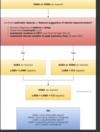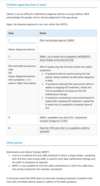Friday [08/10/2021] Flashcards
(502 cards)
How do Lacunar strokes typically present? [2]
Lacunar stroke is a type of stroke that results from occlusion of one of the penetrating arteries that provides blood to the brain’s deep structures. Lacunar strokes most commonly present as a pure motor hemiparesis, pure sensory stroke, sensorimotor stroke, ataxic hemiparesis or dysarthria/clumsy hand syndrome.
What is the classification system for strokes? [1]
Oxford Stroke classification
Criteria assessed by the Oxford Stroke Classification [3]
- unilateral hemiparesis and/or hemisensory loss of the face, arm & leg
- homonymous hemianopia
- higher cognitive dysfunction e.g. dysphasia
How do TACI [c.15%] typically present? Which arteries do they involve? [2]
involves middle and anterior cerebral arteries
all 3 of the above criteria are present
Which arteries do PACI [c.25%] typically effect and how do they present? [2]
involves smaller arteries of anterior circulation e.g. upper or lower division of middle cerebral artery
2 of the above criteria are present
Which arteries do lacunar infarcts typically effects [c.25%] and how they present? [4]
involves perforating arteries around the internal capsule, thalamus and basal ganglia
presents with 1 of the following:
1. unilateral weakness (and/or sensory deficit) of face and arm, arm and leg or all three.
2. pure sensory stroke.
3. ataxic hemiparesis
Which arteries do POCI [c.25%] typically effect and what is the presentation? [4]
involves vertebrobasilar arteries
presents with 1 of the following:
1. cerebellar or brainstem syndromes
2. loss of consciousness
3. isolated homonymous hemianopia
What is a lateral medullary stroke? [3]
Lateral medullary syndrome (posterior inferior cerebellar artery)
aka Wallenberg’s syndrome
ipsilateral: ataxia, nystagmus, dysphagia, facial numbness, cranial nerve palsy e.g. Horner’s
contralateral: limb sensory loss
What is Weber’s syndrome and how does it present? [2]
ipsilateral III palsy
contralateral weakness
COPD still breathless despite using SABA/SAMA and a LABA+ICS, what should you add? [1]
A LAMA like inhaled triotropium
General Mx of COPD [4]
>smoking cessation advice: including offering nicotine replacement therapy, varenicline or bupropion
annual influenza vaccination
one-off pneumococcal vaccination
pulmonary rehabilitation to all people who view themselves as functionally disabled by COPD (usually Medical Research Council [MRC] grade 3 and above)
bronchodilator therapy initially in COPD [2]
a short-acting beta2-agonist (SABA) or short-acting muscarinic antagonist (SAMA) is first-line treatment
for patients who remain breathless or have exacerbations despite using short-acting bronchodilators the next step is determined by whether the patient has ‘asthmatic features/features suggesting steroid responsiveness’
Criteria to determine if patient has asthmatic/steroid responsiveness features []4
any previous, secure diagnosis of asthma or of atopy
a higher blood eosinophil count - note that NICE recommend a full blood count for all patients as part of the work-up
substantial variation in FEV1 over time (at least 400 ml)
substantial diurnal variation in peak expiratory flow (at least 20%)
How to Tx patient if no asthmatic features/features suggesting steroid responsiveness? [2]
add a long-acting beta2-agonist (LABA) + long-acting muscarinic antagonist (LAMA)
if already taking a SAMA, discontinue and switch to a SABA
How to Tx a patient if they have asthmatic features/features suggesting steroid repsiveness? [3]
LABA + inhaled corticosteroid (ICS)
if patients remain breathless or have exacerbations offer triple therapy i.e. LAMA + LABA + ICS
if already taking a SAMA, discontinue and switch to a SABA
NICE recommend the use of combined inhalers where possible
When to include oral theophylline in Tx for COPD? []2
NICE only recommends theophylline after trials of short and long-acting bronchodilators or to people who cannot used inhaled therapy
the dose should be reduced if macrolide or fluoroquinolone antibiotics are co-prescribed
When to include prophylactic antibiotic therapy for COPD Tx [4]
azithromycin prophylaxis is recommended in select patients
patients should not smoke, have optimised standard treatments and continue to have exacerbations
other prerequisites include a CT thorax (to exclude bronchiectasis) and sputum culture (to exclude atypical infections and tuberculosis)
LFTs and an ECG to exclude QT prolongation should also be done as azithromycin can prolong the QT interval
What should be done before giving azithromycin prophylaxis for COPD patients? [2]
LFTs and an ECG to exclude QT prolongation should also be done as azithromycin can prolong the QT interval
When should mucolytics be considered in COPD patients? [1]
should be ‘considered’ in patients with a chronic productive cough and continued if symptoms improve
Features of Cor pulmonale and how to Tx [3]
features include peripheral oedema, raised jugular venous pressure, systolic parasternal heave, loud P2
use a loop diuretic for oedema, consider long-term oxygen therapy
ACE-inhibitors, calcium channel blockers and alpha blockers are not recommended by NICE
Factors which may improve survival in patients with stable COPD [3]
smoking cessation - the single most important intervention in patients who are still smoking
long term oxygen therapy in patients who fit criteria
lung volume reduction surgery in selected patients
WHen is electroconvulsive therapy considered? [2]
Electroconvulsive therapy is a useful treatment option for patients with severe depression refractory to medication (e.g. catatonia) those with psychotic symptoms. For catatonic schizophrenai and severe mania too.
What is the only absolute CI to ECT? [1]
The only absolute contraindications is raised intracranial pressure.
Short-term SE of ECT? [5]
headache
nausea
short term memory impairment
memory loss of events prior to ECT
cardiac arrhythmia































